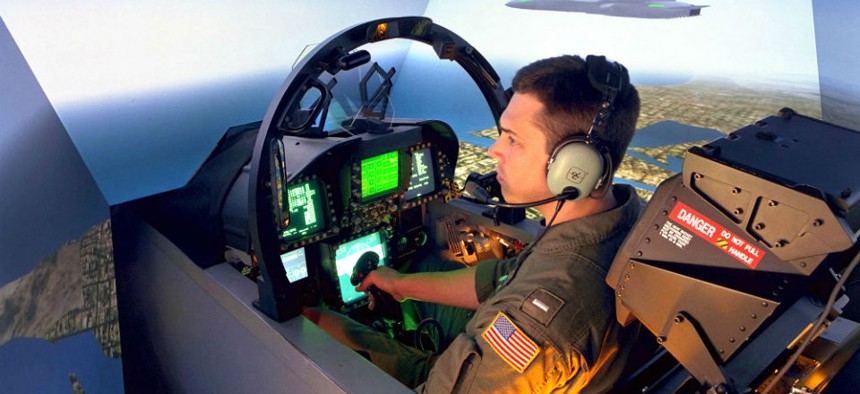
A Navy F/A-18 pilot at Naval Air Station LeMoore, California, trains in 2005 in a simulator built and maintained by industry. Defense file photo
Shifting More Work to Defense Labs Could Save Money, Improve Performance
To keep government technical staff relevant, they need better facilities.
U.S. Defense laboratories and Navy warfare centers are valuable assets for both warfighters and taxpayers, but they are an underused resource and their future is in jeopardy. At the Naval Air Warfare Center Weapons Division we are focusing on three strategic priorities—people (which we discussed in an earlier piece) work and facilities.
The Work
It’s time to reassess the work we are doing in our labs and warfare centers versus industry. In the Naval Air Systems Command, industry executes nearly 89 percent of all acquisition-directed work while government personnel execute the rest, according to Navy data. The department’s Better Buying Power initiatives are making great strides in reducing the actual costs of that 89 percent, but more can and must be done. The focus must now turn to the other 11 percent of work being done by the government workforce. We believe it is time to move some of the 89 percent of work being done by industry back to the government; the savings associated with executing the work at lower cost rates at government facilities and the reduction of proprietary and data rights issues in the future could be substantial.
The Intrepid Tiger and Presidential Helicopter programs are good examples of quality work being completed in-house, at lower costs and with tremendous value to our warfighters and the long-term health of our workforce.
Managing the supply base and overseeing large contracts are clearly the government teams’ tasks, but these actions alone, without meaningful hands-on work, will leave us with a hollow technical team devoid of the talent necessary to perform its most critical task—ensuring the warfighter can effectively and safely execute their missions with technically superior and highly reliable weapons systems. We must ensure we have the right technical balance with industry.
This is by no means a slight to industry; we could not execute the required work without them. This is about the government workforce being technically relevant, something the warfighters and taxpayers require and something industry, frankly, needs as well.
We are out of balance with industry today. A clear way to begin to shift the balance is in the role of lead systems integrator. The government workforce is not positioned to assume the LSI role on a broad scale, but if we engage early in technical development efforts, and whenever else it makes sense, we can build a robust capability. To achieve this rebalancing we must identify where prudent government leadership can and should be exerted. It is also critical for the government to take ownership of critical interfaces, standards, and modular and open architecture designs. The discussion needs to change from worrying about reducing non-Navy work to how do we assign more meaningful work to the warfare centers—the kind of work necessary to develop the technical competence that is essential to delivering superior warfighting capability.
Infrastructure and Facilities
Defense lab infrastructure dates to WWII in many cases. The maintenance cost of this infrastructure is growing due to an increasing number of catastrophic failures. These are resulting not only because of age, but also because of the absence of routine maintenance. Defense needs to develop a deliberate strategy for its labs and facilities that supports research and development. This strategy must include the development of a government-owned and -maintained modeling and simulation environment. Leveraging existing government-owned modeling and simulation capabilities can reduce duplication and investment at prime contractor facilities. Reinvestment in our current lab infrastructure must be the priority before investing in something new, especially at contractor facilities where future use by other programs is inherently limited.
Defense faces intense competition with the private sector for skilled employees. We are further disadvantaged if we cannot provide top quality facilities and equipment for a new generation of engineers and scientists. While we do have some state-of-the-art facilities, many are old and outdated. They hinder work and dissuade potential candidates from joining government service. Consequently, a major part of DOD’s workforce rebuilding strategy needs to focus on raising the quality of its labs and facilities.
We believe that government labs and warfare centers remain an untapped resource in our efforts to improve the acquisition of military goods and services. A focused discussion on work, people and infrastructure is an imperative in these fiscally challenging times, and it is overdue.
Rear Adm. Michael Moran is commander of the Naval Air Warfare Center Weapons Division and assistant commander for Test and Evaluation at Naval Air Systems Command. Scott O’Neil is the executive director of the Naval Air Warfare Center Weapons Division and director for research and engineering at Naval Air Systems Command. The views expressed are their own.






